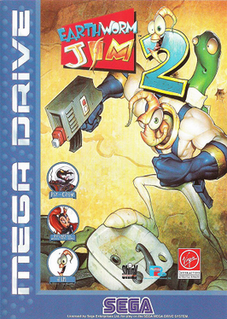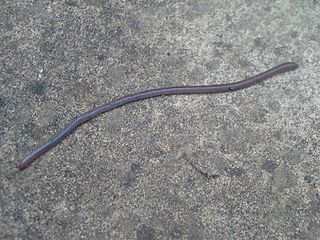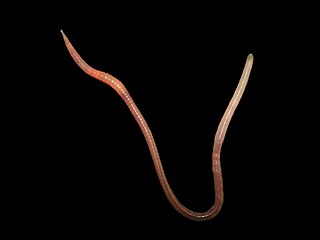
Douglas Richard TenNapel is an American animator, writer, cartoonist, video game designer, and comic book artist whose work has encompassed animated television, video games, and comic books. He is best known for creating Earthworm Jim, a character that spawned a video game series, animated series, and a toy line. He is also the creator of the animated television series Catscratch (2005–2007), which aired on Nickelodeon, and was itself a loose adaptation of TenNapel's comic book limited series Gear.

Earthworm Jim is a 1994 run and gun platform game developed by Shiny Entertainment, featuring an earthworm named Jim, who wears a robotic suit and battles the forces of evil. The game was released for the Sega Genesis, and subsequently ported to a number of other video game consoles.

Lumbricus terrestris is a large, reddish worm species thought to be native to Western Europe, now widely distributed around the world. In some areas where it is an introduced species, some people consider it to be a significant pest for out-competing native worms.

Oligochaeta is a subclass of animals in the phylum Annelida, which is made up of many types of aquatic and terrestrial worms, including all of the various earthworms. Specifically, oligochaetes comprise the terrestrial megadrile earthworms, and freshwater or semiterrestrial microdrile forms, including the tubificids, pot worms and ice worms (Enchytraeidae), blackworms (Lumbriculidae) and several interstitial marine worms.
Sparganophilus, the only genus in the family Sparganophilidae, is a group of long, slender, limicolous (mud-dwelling) earthworms native to North America. The number of species is unknown, most of them are undescribed, throughout the continent and into Central America. One species, S. tamesis, has been introduced into the streams of Europe, where it is now widespread; its synonyms are S. eiseni, S. benhami, S. guatemalensis, S. carnea, S. elongatus, S. cuenoti and, newly, S. langi.

Earthworm Jim 2 is a run and gun platform video game and the sequel to Earthworm Jim, and the second and final game in the Earthworm Jim series developed by original creators Doug TenNapel, David Perry, and Shiny Entertainment. It was released in late 1995 and early 1996 depending on region and video game console, initially being released for the Sega Genesis and Super Nintendo Entertainment System, before being ported to other platforms.

The coast mole or Pacific mole is a medium-sized North American mole found in forested and open areas with moist soils along the Pacific coast from southwestern British Columbia to northwestern California.

The Haplotaxida are one of two orders within the annelid subclass Oligochaeta, the other being the Lumbriculida. No real common name exists, but they are simply referred to as haplotaxids.
The Glossoscolecidae are a large family of earthworms (annelids) which has native representatives in South and Central America. The species Pontoscolex corethrurus has a circumtropical distribution.

Earthworm Jim is an American animated television series based on the video game series of the same name and created by series creator, Doug TenNapel. The series aired on the Kids' WB for two seasons from September 9, 1995, to December 13, 1996. It follows the adventures of the titular character who battles the forces of evil using a robotic suit.
Earthworm Jim is a series of side-scrolling platform games featuring an earthworm named Jim who wears a robotic suit and battles the forces of evil. The series is noted for its platforming and shooting gameplay, surreal humor, and edgy art style. Four games were released in the series: Earthworm Jim, Earthworm Jim 2, Earthworm Jim 3D, and Earthworm Jim: Menace 2 the Galaxy, with the first game released in 1994. The series had laid dormant for almost a decade before Gameloft remade the original game in HD for PlayStation Network and Xbox Live Arcade in 2010. Interplay announced Earthworm Jim 4 in 2008, but little has surfaced since.

An earthworm is a terrestrial invertebrate that belongs to the phylum Annelida. They exhibit a tube-within-a-tube body plan, are externally segmented with corresponding internal segmentation, and usually have setae on all segments. They occur worldwide where soil, water, and temperature allow. Earthworms are commonly found in soil, eating a wide variety of organic matter. This organic matter includes plant matter, living protozoa, rotifers, nematodes, bacteria, fungi, and other microorganisms. An earthworm's digestive system runs the length of its body. It respires through its skin. It has a double transport system made of coelomic fluid that moves within the fluid-filled coelom and a simple, closed circulatory system. It has a central and peripheral nervous system. Its central nervous system consists of two ganglia above the mouth, one on either side, connected to a nerve running along its length to motor neurons and sensory cells in each segment. Large numbers of chemoreceptors concentrate near its mouth. Circumferential and longitudinal muscles edging each segment let the worm move. Similar sets of muscles line the gut, and their actions move digesting food toward the worm's anus.
Rhinodrilus fafner is a presumed extinct giant earthworm from the family Glossoscolecidae. It is only known by the ill-preserved holotype discovered in 1912 near Belo Horizonte in the Brazilian state of Minas Gerais and described in 1918 by German zoologist Wilhelm Michaelsen (1860–1937) from the National History Museum in Hamburg. The collected individual has a length of 210 centimetre and the body which consists of 600 single segments is 24 millimetre in diameter. Along with Amynthas mekongianus and Megascolides australis, Rhinodrilus fafner is among the largest known giant earthworms. Rhinodrilus fafner was confined to a small habitat and vanished possibly due to habitat destruction. It was officially declared extinct by the Brazilian Ministry of Environment (MMA) in 2003. However, the rediscoveries of the Giant Palouse earthworm in 2005 and the Brazilian earthworm Fimoscolex sporadochaetus in 2007 created hope that Rhinodrilus fafner may be found again.
Earthworms are invasive species throughout the world. Of a total of about 6,000 species of earthworm, about 120 species are widely distributed around the globe. These are the peregrine or cosmopolitan earthworms. Some of these are invasive species in many regions.
Samuel James is an American scientist, a researcher specializing in evolutionary biology, focusing on earthworm taxonomy. James, with fellow researchers, has discovered numerous species of annelids, including Diplocardia californiana, Diplocardia woodi, Diplocardia montana, and a new species related to the Giant Palouse earthworm.
Andiorrhinus kuru of the family Glossoscolecidae in the class Oligochaeta is a species of earthworm found in the Alto Orinoco of Amazonas state in Venezuela. Worms of the genus Andiorrhinus are believed to create the Surales landscapes of Venezuela and Colombia, composed of green mounds which form intricate patterns in the floodplains of the Orinoco River of South America.
Enantiodrilus is a genus of South American earthworm in the family Glossoscolecidae.

Pontoscolex is a genus of earthworms in the family Glossoscolecidae, or alternatively, in the family Rhinodrilidae.
Andiorrhinus is a genus of earthworm in the family Glossoscolecidae. The genus contains 37 species subdivided into four subgenera.
Opisthopora is an order of mostly terrestrial worms.








